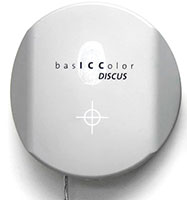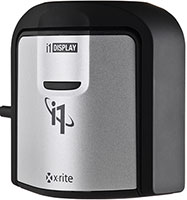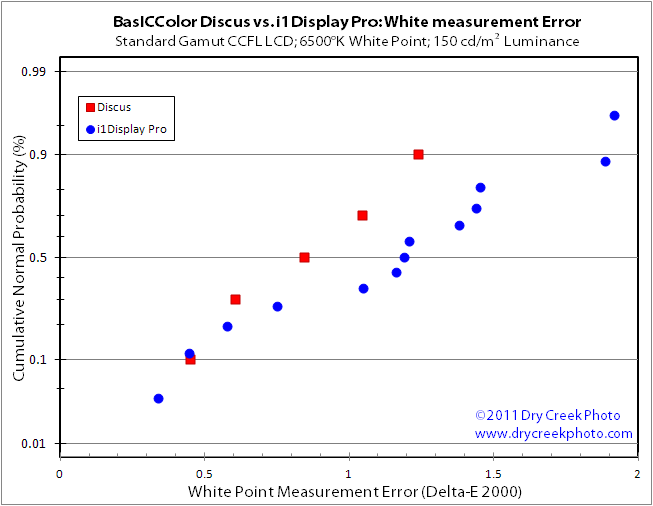BasICColor Discus vs. X-Rite i1Display Pro: Measurement accuracy
Our evaluations of monitor calibration sensors showed the X-Rite i1Display Pro, ColorMunki Display, and the BasICColor Discus to be the best display measurement options available. We noted an advantage in measurement accuracy for the Discus over the i1Display Pro/ColorMunki Display. The mean measurement error of the Discus was consistently lower than that of the X-Rite sensors, but only by a fraction of a Delta-E 2000 (one dE-2000 approximates the minimum visible color difference under ideal conditions).
The street price differential between the competing sensors is not minor. $1300 for the Discus, $250 for the i1Display Pro (alternatively known as the i1Display 3). Is the extra cost worth it?


Handling:
First, let's look at the contenders. The Discus is a large, heavy puck. Emphasis on "puck". The counterweight - slightly smaller than the sensor itself - is an actual hockey puck. The i1Display Pro looks positively tiny by comparison. If you are choosing one to pack in a bag for on-location shooting, the i1Display is the obvious choice.
The comparatively huge size of the Discus is an advantage when performing measurements. It seals out ambient light better than any other sensor we have used. The weight is enough, however, that care must be takes not to tip the monitor screen to far backwards. Otherwise, the Discus can press hard enough onto the screen to distort colors. Measuring a laptop with the Discus is an interesting proposition. The Discus weighs as much as a light laptop, so propping up the screen is essential.
The i1Display Pro is a lightweight by comparison. It is smaller than most older monitor calibration sensors and is positively dwarfed by the Discus. The tall, thin aspect ratio of the device makes placing it on the screen without tipping up an edge a tricky proposition. If the puck lifts from the screen surface even slightly, ambient light can corrupt the readings. We found that using the i1Display Pro in a darkened room gave the most accurate and repeatable results.
Verdict: If small size and light weight are a priority, the i1Display Pro wins handily. For ease of measurement, the Discus is simplicity itself: place it on the screen, and measure away. Ambient light, puck alignment - none of this matters. The huge size of the Discus makes these irrelevant. The i1Display Pro's small size and narrow profile are a hinderance here. The most reliable measurements require a dark room; otherwise very close attention must be paid to how well the puck seals against the screen. Any slight lifting off the screen creates inaccurate measurements.
Accuracy
Both sensors were highly accurate, particularly in comparison to older colorimeters or spectrophotometers. Overall, we measured the average Discus to have a 10-20% lower absolute error than the average i1Display. This relationship held when measuring both white and black levels on standard and wide-gamut CCFL monitors as well as panels using either RGB LED or white LED back lights.
These values do, however, need to be taken in context. Typical added error from using an X-Rite i1Display Pro instead of a BasICColor Discus was less than half a Delta-E 2000. You simply cannot see luminance or color shifts at this level.
Ambient light measurements of blackbody sources (e.g. tungsten lights and natural daylight) were more accurate with the i1Display than the Discus. As mentioned in our review of monitor calibration sensors, this is the result of the Discus currently only being calibrated for ambient light measurements of specific viewing booths. BasICColor promises updates will be forthcoming.
Verdict: The Discus is measurably more accurate than the i1Display Pro. Whether one can see the difference is debatable. Resolving this matter will require using profiling software capable of driving both the Discus and i1Display Pro. Conceivably, small errors in accuracy could compound into visible discontinuities, banding, or posterization.
Thermal Stability
The Discus documentation prominently mentions that it internally compensates for a temperature range of 10°C to 50°C (50°F – 122°F). There is a benefit if these claims hold up; most older monitor profiling sensors needed to be calibrated and used at a consistent temperature for optimum accuracy. A typical CCFL-back light display warms up at least 8°C/15°F above the ambient temperature; LED-backlit displays heat up by a lesser amount. Ideally, you would hang a puck on your display for 20 minutes before beginning measurements to allow the sensor temperature to stabilize. In the real-world, most of us have only limited time to spend on bringing our monitors into line.
To test the Discus, we measured after the internal temperature had stabilized at approximately 10°C, 20°C (68°F), and 30°C (85°F). The unit was only calibrated only once, at 10°C. Marketing claims appear valid: measured values were identical over the full temperature range. The i1Display Pro does not offer thermal specifications but does include built-in temperature compensation. Performing the same tests revealed an average shift in measured values of 0.25 dE-2000 at 10°C vs. 20°C. We measured a consistent 0.05 dE-2000 shift between 20°C and 30°C. Not quite as impressive as the Discus in an absolute sense, but probably "good enough."
Verdict: Once again, the Discus comes out ahead by a margin that is likely invisible. If you need confidence that your measurements are dead-on under almost any circumstances, the Discus provides it. The tiny difference we measured between 20°C and 30°C (68°F and 85°F) is, for all practical purposes, invisible. In a typical studio or office environment, the i1Display Pro can be counted on to deliver accurate measurements.
Conclusions
Unfortunately, as of late-October 2011, no commercially released monitor profiling software drives both the Discus and i1Display Pro. Measuring white and black level accuracy is a good first test of sensor accuracy. Errors in other areas could result in visible artifacts once a profile is built. When a vendor (or the excellent, open-source ArgyllCMS) supports both instruments, we will be able to make a more thorough comparison.
Verdict: From an absolute measurement accuracy perspective, the Discus comes out on top. The Discus provides exceptional stability over a wide temperature range and capably measures all LCD screen technologies. The i1Display/ColorMunki Display has slightly higher absolute errors and more unit-to-unit spread. The differences, however, border on the invisible. Whether the enhanced accuracy of the Discus results in visibly superior monitor profiles awaits software capable of driving both instruments.
Software Notes:
The only commercially available (i.e. not pre-release, covered by NDA) software we had to drive the i1Display Pro was X-Rite's i1Profiler. The basic calibration achieved from i1Profiler was not up to the standards of top-end products such as BasICColor Display or ColorEyes Display for monitors supporting DDC. The third-party applications gave calibrations both visibly and measurably more neutral than what i1Profiler produced. X-Rite's code also created more posterization and banding artifacts in what should have been smooth gradients. This appears largely to be the result of i1Profiler/i1Display performing color LUT adjustments only in the video card, rather than taking advantage of the high bit depth available in most DDC-capable monitor LUTs. Both BasICColor and ColorEyes state that support for the i1Display is coming. We will post results when available.
ArgyllCMS supports the i1Display Pro, albeit using a reverse-engineered driver. In spot testing against the official X-Rite driver, we did not measure any obvious errors in Argyll's implementation. Monitor profiles made with Argyll were very good, of at least comparable quality to i1Profiler, although it takes a large number of patches (2000 is a good start) and a long time to measure.
Statistical details
Warning: Unfriendly territory for most non-science majors.
Given the low relative differences in measurement error between the Discus and i1Display Pro, are the differences significant? The probability plot below shows the difference between the two instruments; the i1Display Pro has a higher median error as well as a larger standard deviation.
Given the comparatively low sample size of five Discus units we had available, the confidence intervals will necessarily be large. That said, performing a Welch's t-test on any of the measurements we performed (black, white, any panel type) did not show a statistically significant difference (95% confidence level) between the Discus and i1Display Pro. Again, this is likely more a reflection of our limited supply of Discus units than a lack of actual difference between the sensors. In all cases, the Discus showed both lower mean error than the i1Display Pro as well as tighter intra-unit variability.

© 2020, Dry Creek Photo. All Rights Reserved.